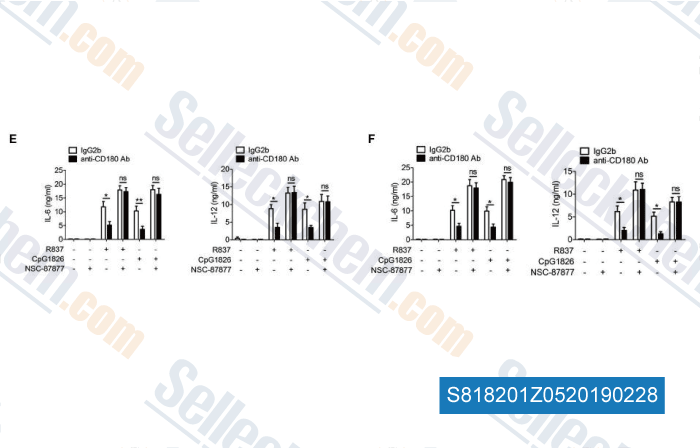|
Toll Free: (877) 796-6397 -- USA and Canada only -- |
Fax: +1-832-582-8590 Orders: +1-832-582-8158 |
Tech Support: +1-832-582-8158 Ext:3 Please provide your Order Number in the email. |
Technical Data
| Formula | C19H13N3O7S2.2Na |
|||
| Molecular Weight | 503.42 | CAS No. | 56932-43-5 | |
| Solubility (25°C)* | In vitro | DMSO | 100 mg/mL (198.64 mM) | |
| Water | 100 mg/mL (198.64 mM) | |||
| Ethanol | Insoluble | |||
|
* <1 mg/ml means slightly soluble or insoluble. * Please note that Selleck tests the solubility of all compounds in-house, and the actual solubility may differ slightly from published values. This is normal and is due to slight batch-to-batch variations. * Room temperature shipping (Stability testing shows this product can be shipped without any cooling measures.) |
||||
Preparing Stock Solutions
Biological Activity
| Description | NSC-87877 is a cell-permeable inhibitor of both SHP-1 and SHP-2 with IC50 values of 355 and 318 nM respectively. It also inhibits EGF-induced Erk1/2 activation in HEK293 cells and significantly reduces MDA-MB-468 cell viability/proliferation. | ||||
|---|---|---|---|---|---|
| Targets |
|
||||
| In vitro | NSC-87877 seems to have no selectivity between human Shp2 and Shp1 in vitro. NSC-87877 inhibits EGF-stimulated Shp2 activation and EGF-induced Erk1/2 activation. NSC-87877 suppresses Erk1/2 activation by a Gab1-Shp2 chimera but does not affect PMA(phorbol 12-myristate 13-acetate)-induced Erk1/2 Activation. NSC-87877 does not inhibit EGF-induced Gab1 tyrosine phosphorylation and Gab1-Shp2 association. NSC-87877 can significantly reduce MDA-MB-468 cell viability/proliferation, especially in combination with a phosphoinositide 3-kinase inhibitor[1]. | ||||
| In vivo | NSC-87877 almost completely prevented EAE(experimental autoimmune encephalomyelitis) development by blocking the accumulation of inflammatory cells in the CNS(central nervous system)[2]. In an intrarenal mouse model of neuroblastoma, NSC-87877 treatment results in decreased tumor growth and increased p53 and p38 activity[3]. Intrathecal administration of NSC-87877 (an SHP2 antagonist; 1, 10, or 100 μM/rat) into the allodynic rats suppresses spinal nerve ligation-induced allodynia, spinal SHP2 and NR2B phosphorylation, and SHP2/phosphorylated SHP2-PSD-95 and PSD-95-NR2B/phosphorylated NR2B coprecipitation[4]. |
Protocol (from reference)
| Cell Assay: |
|
|---|---|
| Animal Study: |
|
References
Customer Product Validation

-
Data from [Data independently produced by , , Front Immunol, 2018, 9:2643]
Selleck's NSC87877 has been cited by 7 publications
| LILRB1-HLA-G axis defines a checkpoint driving natural killer cell exhaustion in tuberculosis [ EMBO Mol Med, 2024, 10.1038/s44321-024-00106-1] | PubMed: 39030302 |
| Guided monocyte fate to FRβ/CD163+ S1 macrophage antagonises atopic dermatitis via fibroblastic matrices in mouse hypodermis [ Cell Mol Life Sci, 2024, 82(1):14] | PubMed: 39720957 |
| Inhibition of PD-1 Alters the SHP1/2-PI3K/Akt Axis to Decrease M1 Polarization of Alveolar Macrophages in Lung Ischemia-Reperfusion Injury [ Inflammation, 2022, 10.1007/s10753-022-01762-6] | PubMed: 36357527 |
| Resistance to allosteric SHP2 inhibition in FGFR-driven cancers through rapid feedback activation of FGFR. [ Oncotarget, 2020, 21;11(3):265-281] | PubMed: 32076487 |
| Regulation of Microtubule Nucleation in Mouse Bone Marrow-Derived Mast Cells by Protein Tyrosine Phosphatase SHP-1 [ Cells, 2019, 8(4)] | PubMed: 30979083 |
| Nogo-A/Pir-B/TrkB Signaling Pathway Activation Inhibits Neuronal Survival and Axonal Regeneration After Experimental Intracerebral Hemorrhage in Rats. [ J Mol Neurosci, 2019, 69(3):360-370] | PubMed: 31286407 |
| CD180 Ligation Inhibits TLR7- and TLR9-Mediated Activation of Macrophages and Dendritic Cells Through the Lyn-SHP-1/2 Axis in Murine Lupus [Yang Y, et al. Front Immunol, 2018, 9:2643] | PubMed: 30498494 |
RETURN POLICY
Selleck Chemical’s Unconditional Return Policy ensures a smooth online shopping experience for our customers. If you are in any way unsatisfied with your purchase, you may return any item(s) within 7 days of receiving it. In the event of product quality issues, either protocol related or product related problems, you may return any item(s) within 365 days from the original purchase date. Please follow the instructions below when returning products.
SHIPPING AND STORAGE
Selleck products are transported at room temperature. If you receive the product at room temperature, please rest assured, the Selleck Quality Inspection Department has conducted experiments to verify that the normal temperature placement of one month will not affect the biological activity of powder products. After collecting, please store the product according to the requirements described in the datasheet. Most Selleck products are stable under the recommended conditions.
NOT FOR HUMAN, VETERINARY DIAGNOSTIC OR THERAPEUTIC USE.
